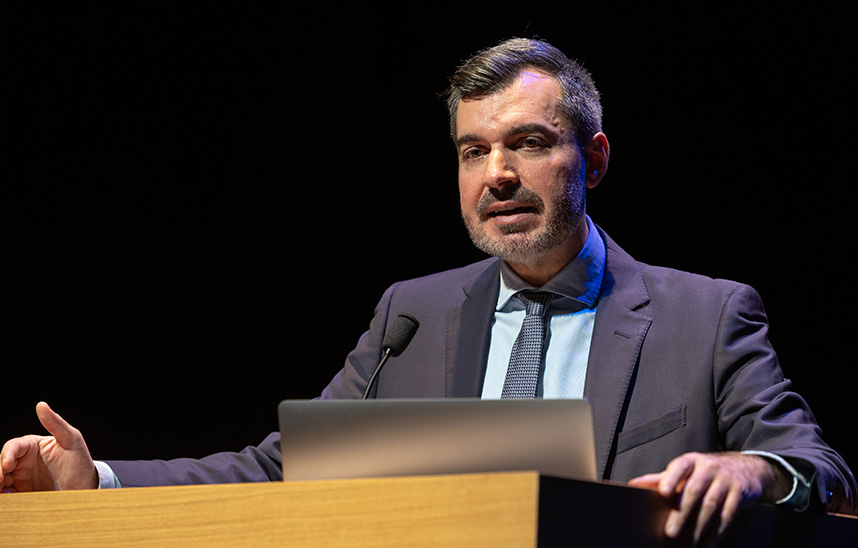“Desire is one of the most consubstantial traits of the human condition”
David Garcia Cueto, Head of department from the Prado Museum, gives the third session of the Francisco Calvo Serraller cycle at the University of Navarra

30 | 01 | 2025
Historian David García Cueto , Head of department of Italian and French Painting until 1800 from the Prado Museum, has been in charge of giving the third session of the Francisco Calvo Serraller lecture series that the School of Philosophy and Letters of the University of Navarra organizes in partnership with the Friends of the Prado Museum Foundation.
During his speech, in which he addressed “Desire in 17th century painting, between fascination and censorship”, he alluded to ancient Rome, stating that “Nudity in the ancient world was not harmful and the representation of intimate encounters was a celebration of life or even propitiatory of fertility, abundance or happiness itself”. As he explained, this vision was substantially altered in the Middle Ages. average , to return during the Renaissance and disappear again in the 16th century.
The first act of censorship in Europe, he said, occurred when Ferdinand II came to the throne of the Austro-Hungarian Empire. His predecessor, Rudolf II, was a great collector of art, including paintings considered lewd, but the new emperor decided to take radical measures. The specialist said that “he advocated burning all the paintings that were at that time in Prague Castle in an indecent manner in a large pile in the open air. Today, of course, we art historians regret this very much.” However, as he explained, many evaded censorship thanks to clever stratagems. Among other things, he mentioned that they tended to “age” the works, adopting an older pictorial style or indicating dates prior to the Council of Trent: “In this way, the authorities would not have been able to make a retrospective condemnation.”
Some famous artists, the art historian said, also managed to escape the restrictions. For example, Guido Reni depicted nudes of Bacchus and Ariadne without being pursued by the authorities because, “he thought that by painting such pictures, he had no intention of offending God,” the historian explained. speaker taking up the artist's own words. Others, such as Pedro Pablo Rubens, rejected authority outright. This is how García Cueto recounted it: “Cardinal Infante Don Fernando, brother of Philip IV, who spent some time in Flanders, asked Rubens to make a painting in which naked women appeared a little more chaste, but the painter replied , “No, Your Highness, in no way, because it must be for the good of art .”
The historian has concluded his lecture He emphasised the gaze of female artists in later centuries: “In the Renaissance and Baroque, nudes were commissioned by men, made by men and intended for a fundamentally male contemplation.” Except for Artemisia Gentileschi, there were not many renowned female artists, although the expert has qualified that “this does not mean that today any of us, man or woman, can enjoy contemplating these works.” Thus, he has given as more contemporary examples Tamara de Lempicka and Cecily Brown, who represented the nude with their own sensitivity. “We see that desire continues to be a topical issue in artistic creation,” he has affirmed.
After passion, death and sensuality, the last session of this edition will focus on love. It will take place degree scroll “ Ubi amor, ibi oculus. The perspective of love in artistic creation” will be taught by art historian Noelia García Pérez.




